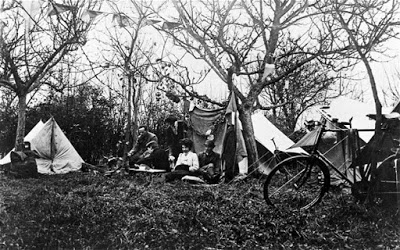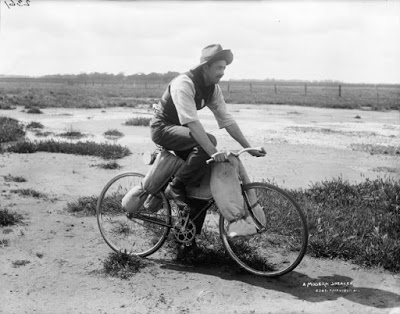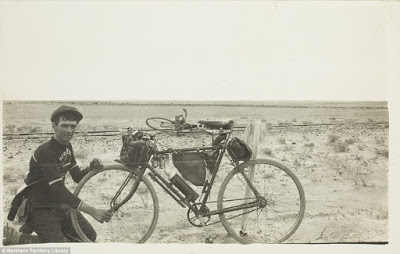Bikepacking is like touring, just as pears are like apples … they look different, they smell different and they taste different but they’re both fruit. Some people will dismiss that last statement, believing wholeheartedly that ‘bikepacking’ is just a fancy new name for touring dreamt up by suited marketeers in an effort to sell the poor unsuspecting cyclist something new and shiny … but it isn’t. There really are differences between the two, some subtle, others not so. Today, there’s possibly enough differences in equipment alone to validate the point but the real divide is borne from outlook and attitude.
People have loaded camping equipment onto bicycles for as long as there’s been bicycles. The bicycle as we know it today, precedes the surfaced road by a good number of years, so if the first distinction we try and make between bikepacking and touring is off-road verses on-road, it could be argued that the first bikepackers appeared sometime around 1870 … although it would be over 100 years before the term ‘bikepacking’ makes a appearance. In fact, it would be 1973 when an article entitled “Bikepacking across Alaska and Canada” by Dan Burden appeared in National Geographic and chronicled a 3103 mile trip from Anchorage to Missoula, Montana.
Obviously people have ‘toured’ off-road long before 1973 but generally those that did, had more in common with the modern view of the stripped down bikepacker than the obese, over burdened tourer. The desire to carry less while still carrying enough to survive comfortably is possibly one of the major differences between our apples and pears and it’s by no means a recent phenomenon. In 1901 Thomas Hiram Holding set up the Association of Cycle Campers. Thomas Holding was a prolific camper and wrote numerous books including ‘Cycle and Camp’ published in 1898, this became the catalyst for the formation of the association, which by 1906 had a membership in the hundreds. It’s easy to imagine that Mr Hiram and friends struggled under heavy loads of canvas, blankets and cast iron but the reality was actually quite different. A kit list from the time reveals that the approach to cycle camping in the early 1900’s was very similar to that of today’s bikepacker, a 907g single skin tent, a down quilt weighing 737g and even an air pillow (85g) are all listed. The combined weight for the entire list tipped the scales at less than 10lb, something the majority of us would be very happy to achieve over 100 years later.
 |
| Bear Bones Winter Bivvy 1902. |
Around the same time as Mr Holding was knocking up his silk tents in England, sheep shearers on the other side of the World were packing their bikes and riding 1000’s of miles across the Australian outback. Did they use panniers and racks? Did they ride 40 miles between campsites and hot showers? – No. The silhoutte of their bikes actually looked very similar to something you’d expect to see in 2015 on the Tour Divide, Highland Trail or WRT. The luggage used, mainly comprised of canvas frame bags and straps to hold sacks to the handlebars or under the saddle and their nights were spent directly on the side of the trail under simple shelters … sound familiar? It should.
 |
| Aussie sheep shearer on his way to work. |
The modern concept of ‘touring’ with all that entails, didn’t really exist until the seventies with the introduction of what we’d recognise today as a ‘pannier’. Even throughout the 50’s and 60’s the majority of touring cyclists carried very little by the standards of today. What they did carry was usually stuffed into or strapped onto a relatively small saddlebag … the thought of loading a bike with 80+ litres of storage capacity would have seemed very alien.
 |
| It’s obviously someones idea of a good time. |
In reality, how people choose to carry their kit is of little importance, it’s what they choose to carry that matters … the method is only a manifestation of attitude. Maybe bikepacking requires a level of masochism? A willingness to sacrifice and suffer? Or perhaps it requires self-discipline, a higher level of skill and clear judgement? Knowing that you’re carrying only those things you really need rather than those things you want can be a difficult pill to swallow for many … much easier to pack a plethora of ‘safety net gear’ to make up for a lack of ability and shield yourself from any potential unpleasantness the great outdoors may serve up. Given the requirement for skill and self reliance, it’s little surprise that bikepackers are often viewed as being geeky, nerds or mildly mad when they choose to spend time honing their techniques rather than just throwing yet another kilo of junk into the panniers.
 |
| 3000km – 28 days – 100 years ago. |
Bikepacking isn’t something new, it’s the rediscovery of something as old as the bicycle itself. Its heritage is a long one dating back well over 100 years. It’s not the bastard child of mountain biking and touring, conceived in some late 90’s one night stand, it’s the legitimate heir to cycle camping with a direct lineage going back over a century. Thomas Holding, the Aussie shearers and cycle campers of the 1950’s understood the benefits of travelling light and had the skills to do it … bikepackers in all but name.





Where does someone like Ian Hibell into this schema? He's probably the most adventurous of adventure cyclists. Rode a touring bike with panniers.
He was a true adventurer and at the time 'fashion' dictated racks and panniers … but I can't help but think crossing the Darien Gap might have been easier without.
I'd say it all depends on the nature of the adventure. If you're crossing a desert and need to carry a lot of water with you, a rear rack is a good idea. Minimalist bike-packing isn't the optimal approach. No amount of titanium silnylon geekery can make 20 litres of water weigh any less than 20kg.
Kit bloat and kitchensinkism can affect both tourers and bikepackers. I saw a rider on the BB Winter Event who had clearly gone out and bought every item of soft luggage available to man, and filled them all to the brim then managed to lash them to his bike, with a big rucksack for good measure. I rucksack! If your bikepacking luggage includes a rucksack then you either need to reduce your stuff, or get some panniers! No self-respecting, vertebrae-respecting cycle camper of the golden age would have ever countenanced a rucksack on a bike.
What I see today is that cycle touring is most often about getting from A to B while bikepacking is more about getting from A to B or maybe just A to A via some interesting, potentially uncertain and challenging off-road route. So it's about seeking out adventure and adversity rather than letting it appear of its own accord, which is more the traditional cycle tourist approach. The bike packer's mindset is that if nothing epic happens, then they've somehow been cheated, whereas the cycle tourist is perfectly happy to have experienced no hardship, though if things turn out not so well, then they are happy to press on (or sit it out).
Cycle tourists have always seen the appeal of going lightweight, it's not something they gave up on in the 1970s. See this piece by the CTC's chief technical officer Chris Juden from 2008: http://www.ctc.org.uk/file/member/200809038.pdf
As a long time cycle tourist dipping a toe into the world of bikepacking, I prefer to stay on quiet roads as far as possible, only going off road when I have to – ie. to cross a mountain range where there's no road. So the ride may be 80% road and 20% off-road in distance, probably more equal in terms of time, and I'll consider a traditional touring bike or a new 'adventure road' bike as the equal of a typical fat tyred mtb. I'm reluctant to suffer riding 60 miles on the road on massive knobby tyres just so I can ride some technical bits of off-road. I'll happily pay the price of an easier ride on the road by walking / carrying my bike over any really tricky off-road bits. I might take a couple of small panniers or I might take a saddlebag. I think this is closer to the old tradition of pass-storming than it is to modern bike-packing. But it's not cycling from hot shower to hot shower with five changes of clothes and a Trangia. Though there's nothing wrong with that either. There's nothing that says travelling by bike must involve suffering or material deprivation. When it comes down to it, people who travel on bike have more in common with eachother. We're all basically fruit, in a world made of lard.
And as an interesting historical footnote, the Association of Cycle Campers evolved into the Camping and Caravanning Club. And Aussie sheep shearers now get about in pick-up trucks. And Dervla Murphy rode from Ireland to India on a one-geared town bike with panniers (and a gun).
I agree with much of that but I have to say, the point of bikepacking isn't to suffer or deprive yourself of anything, it's to make yourself as comfortable as possible while carrying the least possible because that generally makes riding much more enjoyable. It's something that takes time and practice to get right and it isn't reliant on the latest materiels or manufacturing methods as some people believe … it's much more about the skills of the individual.
Also, I wasn't trying to imply that "touring is bad", I was simply trying to highlight that bikepacking isn't simply a new name for touring. It's something with an ethos that goes back much, much further. I make no distinction about bikes … you don't need a mountain bike, you don't need an adventure bike or a fat bike, you just need 'a bike' and the correct attitude and spirit.
Pass-storming … were the riders not going out looking for and with the sole intention of riding mountain passes? Which many may see as getting from A to A via some interesting, potentially uncertain and challenging off-road route, seeking out adventure and adversity. ;o)
The bags that Ian Hibbell designed and used were available in the late '70's from Carradice and, as a set, were a pair of panniers and a handlebar bag. Quite well thought out for the time but I always used to find them very small. They used to hold a weeks hostelling gear but not a few days camping given that an affordable, lightish two man tent might weigh 7lbs and have bulk to match.
I eventually discovered that Ian H. also had an open tarp on the top of the rack that, even when rolled over to enclose his kit, stretched across the rear rack and the tops of the panniers and was quite deep. He wasn't a man who worried about the weight of his bike. I've seen one of them somewhere (National Cycle Museum?) and it has front and rear racks welded on.
Like the gent above I prefer the 'quiet' lanes and occasional off road, towpaths are a favourite, and the all in line with the bike frame kit of bikepacking is by far more manageable than panniers through, or over, gates and stiles.
Another excellent post Stu. Thanks
ps I should mention that I sold my Ian Hibell pannier set a few years ago, not long after his death, on eBay for more than I originally paid although without adjustment for inflation :0)
On pass-storming, the way I understand it, it was more akin to fell walking, whereas mountain biking is more akin to rock climbing, if that makes any sense. Both involve riding a bike in the mountains, but there's a different emphasis. And of course a fell-walker one day can be a rock climber the next (if you're walking the via ferrata in the Dolomites, for instance).
The point I was making about the discomfort in bike-packing was more to do with the choice of surface. In Britain you can get more or less anywhere on lanes. If someone prefers to take the bridleway when there's a parallel lane, then I deduce they are looking for something specific, something off-road, something rougher than tarmac, and that's what leads people to say bike-packing is off-road touring, with all that that implies in terms of bike choice and luggage carrying capacity.
One aspect of this that neither of us has mentioned is duration. What works for a night, as couple of nights, or maybe a week, might not work for a 6 month ride. Much depends on the rider and someone who you might call a bike packer one day might look like a tourer on another. On a 400km audax I'm happy to crash for a few hours in a bus shelter or a church porch, with no specific camping gear at all, when I know it's a one night thing. If I were to do that for a week, or a month, the thrill of roughing it might wear a bit thin. Each of has a 'comfort thermostat', which varies with all kinds of things, and which dictates a variety of optimal bike/kit choices depending on the circumstances, and some of those optimal choices may include panniers. So it's more of a continuum than an apples/pears dichotomy.
I don't think anyone is saying that bike-packing is a new name for touring. I'd say, at the risk of sounding bland, that it's just another branch of travel by bike. The problem comes when someone wants to take a touring load, because that's what they feel they need for their desired level of comfort, but wants to do so with bike-packing luggage, because bike-packing is the hip new thing and cycle touring is something old men do in beards. Such a person either needs to find out how to get by with less stuff (which takes time and sometimes uncomfortable trial-and-error, as you say), or embrace the pannier.
Stu, I should add that this is Jack Thurston posting as Unknown. We did meet briefly in January. I can't find a way of making it non-anonymous using the comment as tool as I don't have any of the Open ID etc etc credentials. And I should add that I really enjoy the posts on here – some of the best thinking, and writing, about cycling around right now.
Evening Jack … I enjoy the writing and sometimes even the thinking, so it's nice to know it's not all wasted time ;o)
Worth having a browse of this gallery of photos from Central London CTC, showing that the kind of light(isn) weight cycle adventuring that you talk about as being commonplace in the 50s and 60s was going strong in the 80s.
http://www.centrallondonctc.org.uk/gallery?album=30YearsOfCentralLondonTheFirstDecade
And the accompanying written history of the period:
http://www.centrallondonctc.org.uk/history
Looking at images from the 90s and 00s it does seem that the panniers are getting bigger:
http://www.centrallondonctc.org.uk/gallery?album=30YearsOfCentralLondonTheNextTwoDecades
I am wondering whether this may be in part due to the lower gearing that was beginning to be available, not least due to the filtering of MTB gear technology into road and touring bikes. This means you can winch yourself up any hill, even with a huge load. Recall that earlier cycle tourists would have been on single speed or maybe 3 speed machines, and that, together with the weight of bikes at the time, would have been an added incentive to keep luggage to the absolute minimum.
Jack